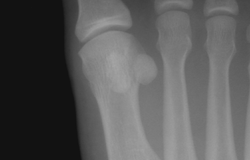- Sesamoid bone
-
Bone: Sesamoid bone Sagittal section of right knee-joint. Sesamoid bones at the distal end of the first metatarsal bone of the foot. Latin ossa sesamoidea In anatomy, a sesamoid bone is a bone embedded within a tendon.
Sesamoids are found in locations where a tendon passes over a joint, such as the hand, knee, and foot. Functionally, they act to protect the tendon and to increase its mechanical effect. The presence of the sesamoid bone holds the tendon slightly farther away from the center of the joint and thus increases its moment arm. Sesamoid bones also prevent the tendon from flattening into the joint as tension increases and therefore also maintain a more consistent moment arm through a variety of possible tendon loads. This differs from menisci, which are made of cartilage and rather act to disperse the weight of the body on joints and reduce friction during movement.
Contents
Human anatomy
Sesamoid bones can be found on joints throughout the body, including:
- In the knee — the patella (within the quadriceps tendon).
- In the hand — two sesamoid bones are commonly found in the distal portions of the first metacarpal bone (within the tendons of adductor pollicis and flexor pollicis brevis). There is also commonly a sesamoid bone in distal portions of the second metacarpal bone. The pisiform of the wrist is a sesamoid bone (within the tendon of flexor carpi ulnaris).[1]
- In the foot - the first metatarsal bone usually has two sesamoid bones at its connection to the big toe (both within the tendon of flexor hallucis brevis).[2] In some people, only a single sesamoid is found on the first MCP.
Injuries and variation
- A common foot ailment in dancers is sesamoiditis.
- A bi-partite sesamoid bone is when the sesamoids are in 2 separate entities — usually congenital, but may be related to a history of trauma.
In other animals
In equine anatomy, the term sesamoid bone usually refers to the two sesamoid bones found at the back of the fetlock or metacarpophalangeal/metatarsophalangeal joints in both hindlimbs and forelimbs. Strictly these should be termed the proximal sesamoid bones whereas the navicular bone should be referred to as the distal sesamoid bone. The patella is also a form of sesamoid bone in the horse.
In both the giant panda[3] and the red panda,[4] the radial sesamoid is larger than the same bone in counterparts such as bears. It is primarily a bony support for the pad above it, allowing the panda's other digits to grasp bamboo while eating it. The panda's thumb is often cited as a classical example of exaptation, where a trait evolved for one purpose is commandeered for another.[5]
See also
Footnotes
- ^ Tim D. White, Human Osteology, 2nd edition (San Diego: Academic Press, 2000), 199, 205.
- ^ White, Human Osteology, 2nd edition, 257-261.
- ^ Arthro.com: The Panda's Thumb
- ^ Evidence of a false thumb in a fossil carnivore clarifies the evolution of pandas PNAS December 30, 2005
- ^ The Panda's Peculiar Thumb, Nature Magazine Vol. LXXXVII No. 9, Nov. 1978, by Stephen J. Gould
References
- Gray's Anatomy (1918) (Bartleby)
Musculoskeletal system · connective tissue: bone and cartilage (TA A02.0, TH H3.01, GA 2.86–95) Cartilage perichondrium · fibrocartilage callus · metaphysis
cells (chondroblast · chondrocyte)
types (hyaline · elastic · fibrous)Bone CycleTypesRegionsStructureosteon / Haversian system · Haversian canals · Volkmann's canals · connective tissue (endosteum · periosteum) · Sharpey's fibres · enthesis · lacunae · canaliculi · trabeculae · medullary cavity · bone marrowShapesCategories:- Sesamoid bones
- Skeletal system
- Horse anatomy
Wikimedia Foundation. 2010.


